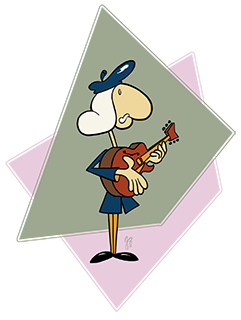|
This material comes largely from this video and this video.
The Mixolydian mode is an 'uneven' scale - it only has 7 notes, while we ordinarily play in 4/4 time. If you continue marching up or down the the Mixolydian scale tones in sequence, after 8 beats, your scale's chord tones are no longer hitting on the down beats -- they are flipped -- giving an awkward sound. The solution is the 'Bebop Scale.' The C7 bebop scale has extra 'passing tone' -- the B natural (the Major 7 of C). C Mixolydian C-D-E-F-G-A-Bb-C 1-2-3-4-5-6-b7-1 C 'Dominant Bebop' C-D-E-F-G-A-Bb-B-C 1-2-3-4-5-6-b7-7-1 The 8 notes of the 'Bebop' scale ensures you always fall on the downbeat when you start on a chord tone, even if you march into the next octave. The Minor modes (like Dorian) have the same problem when playing over a minor -- the chord tones fall off the downbeat if you do a run 8 beats or more. The Jazz Minor (aka Melodic Minor) is essentially the Major scale with a flat 3rd. C-D-Eb-F-G-A-B-C 1-2-b3-4-5-6-7-1 However, this scale only has 7 notes. You can turn the Jazz Minor into an 8-tone 'Bebop' scale to enhance the chord tones on downbeats after you enter the successive octave. There are two ideas of how to construct the Jazz Minor Bebop to get 8 tones -- either use the #5/b13 or the flat 7. The first solution is adding the extra passing tone of a flat 13, also known as the sharp 5. G 'Jazz Minor Bebop' C-D-Eb-F-G-G#-A-B-C 1-2-b3-4-5-#5(b13)-13-7-1 descending, you spell the #5/b13 as Ab. This bebop scale ensures the 'quality' of the Major-minor scale. Another approach, is to construct the 'Jazz Minor Bebop' by incorporating both the Major and Minor 7. C-D-Eb-F-G-A-Bb-B-C 1-2-b3-4-5-6-b7-7-1 In classical music, the minor scales are different ascending and descending. In order to add the 'jazzy flavor' of a Major 3rd with a Minor chord, you can choose to use incorporate Major 3rd as the descending 'Bebop Minor' when doing downward runs. 'Jazz Minor Bebop Descend Variation' C-Bb-A-G-F-E-Eb-D-C 1-b7-6-5-4-3-b3-2-1 or you can descend with the Dominant Bebop scale shown at the beginning. You can any play of these above mentioned scales over a ii-V. For instance, you can play the Jazz Minor ascending, and Bebop descending. The beauty of these scales is that when you move into the next octave, you are still playing chord tones on the downbeats. The videos linked above also talk about 'Broken Chords' which simply mean, phrasing chord tones, like an arpeggio. Any arpeggio within the diatonic progression of a key can create a useful phrase in a solo. The videos also briefly touch on half-step in bebop. Half steps can be used to 'keep your footing' like in bebop scales, or be used as 'approach' tones in the key, or be used to help 'enclose' a chord tone. |
HI!I'm teaching myself jazz guitar... these are my notes. Archives
February 2020
Categories
All
|







 RSS Feed
RSS Feed
